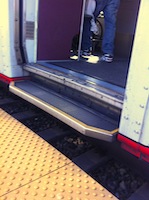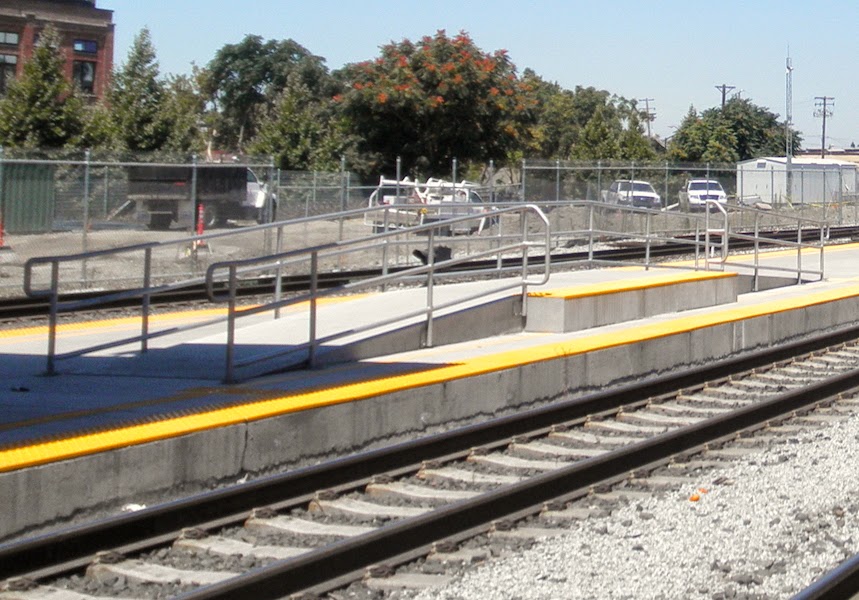10 September 2014
Compatibility, Done Backwards

Steps from an 8-inch platform
into a Bombardier bilevel car
with a 25-inch floor. The first
step is 10", the second 7" Caltrain justifies its desire to procure a new EMU fleet with 25" floor height thus:
With a 25” floor threshold, the new fleet will still be compatible with the existing fleet and platforms and could transition to level boarding over time. "Existing fleet" in this context means the Bombardier bi-level cars, known to the layperson as the red Baby Bullet cars. Caltrain plans to keep these cars for a few years after the new EMUs arrive. The Bombardiers already have a floor height of 25" above the rail, although existing 8" platforms currently require two steps up, as seen in the photo at right.
The statement above sounds like a genuine interest in compatibility, and at first reading seem to make sense. But let's analyze Caltrain's ideas about compatibility more closely.
Compatibility with Existing Fleet
Suppose for a moment that we planned to "transition to level boarding over time" at 25 inches, because we think it's smart to match the floor level of the Bombardier cars so that we can keep using them after the conversion to level boarding. Is that even a feasible scenario?
The "before" and "after" cases are straightforward. Before transition is just the way things are today. After transition is complete, the entry steps are easily modified to match the interior floor height, achieving gap-free level boarding just like
this photo of Utah FrontRunner Bombardier cars docked at 25-inch platforms.

It's the "during" case where things fall apart: because the step modification involves a one-time visit to the shop, there is no way for a Bombardier train (or any other train in Caltrain's existing fleet!) to serve an evolving mix of high and low platforms in daily service during the "transition to level boarding over time". There would be a 7-inch deep, foot-wide trough between the platform and the car floor that would qualify as a serious tripping hazard even for an able-bodied passenger. This configuration would be illegal under a number of federal regulations. The Bombardier fleet would have reduced utility for the duration of the transition to level boarding,
likely to be several years. So let's say it again:
Bombardier cars cannot serve an evolving mix of 8" and 25" platforms during a transition to level boarding over time.
Once the transition to level boarding is complete, maybe in the mid-2030s, the Bombardier cars will be at the end of their useful life. Given the limited remaining lifetime of the Bombardier cars, their inflexibility during transition, and their dwindling residual value, there is little value in matching the new level boarding platform height to the Bombardier cars. There may even be
negative value in doing so.
Compatibility with Existing Platforms

Mini-high platform built on top of
8-inch platform. The top of the
mini-high is at 22 inches ATOR.
This is primarily an issue of wheelchair boarding. Matching the new EMUs to the 25-inch floor height of Bombardier cars allows Caltrain to procure EMUs without vehicle-borne wheelchair lifts, which are expensive to purchase and maintain. Instead, the EMUs would re-use the existing mini-high platforms to perform wheelchair boarding, using a bridge plate to span the large gap between the mini-high platform and the train. (Recall this ~3-foot gap is present in the first place because of a
California PUC regulation on side clearances for freight trains).
To ensure that a wheelchair user can safely navigate across the bridge plate, its maximum slope is set by ADA law under
49 CFR 38.95 as follows:
- 1-in-4 for a height change of less than 3 inches from platform to train
- 1-in-6 for a height change between 3 and 6 inches
- 1-in-8 for a height change between 6 and 9 inches
- 1-in-12 (similar to building wheelchair ramps) for a height change greater than 9 inches
Suppose for a moment that we planned to buy EMUs that have to make use of the existing mini-high platforms, which are built 22 inches above the rail and set back 8 feet from the track center line. What we have is a geometry problem: the ADA slope regulations constrain the vehicle floor height that is reachable from the existing mini-high platforms. The maximum reachable height is about 27 inches, which (after accounting for a bit of margin) may explain Caltrain's fixation on 25 inches.
But then consider also: each mini-high platform is worth (generously) about $150k to replace. On a system with 27 stations, 54 mini-high platforms will cost about $8 million to replace. While that sounds like a lot of money ("Eight Million Dollars!") this sum is a pittance on the scale of the investments being contemplated. Eight million dollars is two percent of the cost of the new EMU fleet, and less than a percent of the cost of the electrification project. Put simply, the mini-high platforms have insignificant value and are a trifle to replace. Designing Caltrain's future around them is certainly penny wise, but quite possibly pound foolish.
Thinking Inside the Box
While Caltrain is no doubt very attached to its growing collection of mini-high platforms and its expanding Bombardier fleet, neither of these items should drive the design of the future platform interface for level boarding. 25 inches is a fine platform height, but selecting it on the basis of these two perceived "constraints"
could prove very unwise in the long run.
Caltrain appears to have an uncomfortable relationship with the level boarding issue: it's a distraction from their current big project to electrify the railroad, it's logistically far more challenging to plan for than just stringing up some wire, it involves fighting clearance regulations that are dear to the freight railroads, it isn't funded, and they'd rather not think about it right now because the issue gives them a headache.
But what sort of modernization is this if level boarding becomes a careless afterthought?










